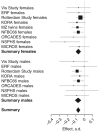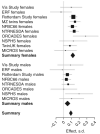Loci influencing lipid levels and coronary heart disease risk in 16 European population cohorts
- PMID: 19060911
- PMCID: PMC2687074
- DOI: 10.1038/ng.269
Loci influencing lipid levels and coronary heart disease risk in 16 European population cohorts
Abstract
Recent genome-wide association (GWA) studies of lipids have been conducted in samples ascertained for other phenotypes, particularly diabetes. Here we report the first GWA analysis of loci affecting total cholesterol (TC), low-density lipoprotein (LDL) cholesterol, high-density lipoprotein (HDL) cholesterol and triglycerides sampled randomly from 16 population-based cohorts and genotyped using mainly the Illumina HumanHap300-Duo platform. Our study included a total of 17,797-22,562 persons, aged 18-104 years and from geographic regions spanning from the Nordic countries to Southern Europe. We established 22 loci associated with serum lipid levels at a genome-wide significance level (P < 5 x 10(-8)), including 16 loci that were identified by previous GWA studies. The six newly identified loci in our cohort samples are ABCG5 (TC, P = 1.5 x 10(-11); LDL, P = 2.6 x 10(-10)), TMEM57 (TC, P = 5.4 x 10(-10)), CTCF-PRMT8 region (HDL, P = 8.3 x 10(-16)), DNAH11 (LDL, P = 6.1 x 10(-9)), FADS3-FADS2 (TC, P = 1.5 x 10(-10); LDL, P = 4.4 x 10(-13)) and MADD-FOLH1 region (HDL, P = 6 x 10(-11)). For three loci, effect sizes differed significantly by sex. Genetic risk scores based on lipid loci explain up to 4.8% of variation in lipids and were also associated with increased intima media thickness (P = 0.001) and coronary heart disease incidence (P = 0.04). The genetic risk score improves the screening of high-risk groups of dyslipidemia over classical risk factors.
Figures



Comment in
-
Cohort studies and the genetics of complex disease.Nat Genet. 2009 Jan;41(1):5-6. doi: 10.1038/ng0109-5. Nat Genet. 2009. PMID: 19112455 No abstract available.
References
-
- Kannel WBDT, Kagan A, Revotskie N, Stokes JI. Factors of risk in the development of coronary heart disease-six year follow-up experience. The Framingham Study. Ann. Intern. Med. 1961;55:33–50. - PubMed
-
- Miller NE, Letter MG. High-density lipoprotein and atherosclerosis. Lancet. 1975;1:1033. - PubMed
-
- Kathiresan S, Musunuru K, Orho-Melander M. Defining the spectrum of alleles that contribute to blood lipid concentrations in humans. Curr. Opin. Lipidol. 2008;19:122–127. - PubMed
Publication types
MeSH terms
Substances
Grants and funding
LinkOut - more resources
Full Text Sources
Other Literature Sources
Molecular Biology Databases
Miscellaneous

